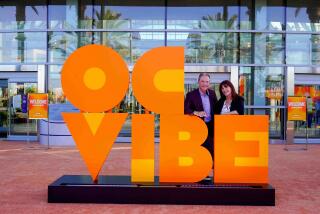Age of Kitsch and Clutter Fading Fast in Anaheim
When wrecking balls demolish the Rip Van Winkle Motel and circus-tent-styled Melodyland this summer, some will cheer Anaheim’s continued transformation into a modern resort city with thousands of hotel rooms, towering palm trees and manicured medians bursting with lush, yellow flowers.
Others long for the city of old and see only what is disappearing, bit by kitschy bit.
Since 1995, when Anaheim embarked on its resort makeover, the neon signs have been vanishing. Themed hotels and just about everything Googie--that exaggerated, space-age diner architecture from the 1950s and ‘60s--also is gone.
With it, some say, went the city’s personality.
“All that character is gone,” said Daniel Paul, a Googie architecture fan who grew up near Disneyland. “What is there now is not an honest assessment of the fun and whimsy that people associate with Disneyland. It’s something ... much more sterile. It’s the out-churning of a bunch of marketing studies.”
What city officials liken to a renaissance Paul calls a “blandification.”
Not so long ago, for every “land” at Disneyland, it seemed there was a matching motel on the outside. Stovall’s Space Age Motel or Cosmic Lodge weren’t much of a stretch from Tomorrowland, and some had pools shaped like space capsules. Satellites and even a flying saucer were perched on roofs. Cheesy advertisements beckoned tourists by offering “moon-level luxury at down-to-earth prices.”
The tiki totem pole outside the Samoa Motel on Katella Avenue could have been transplanted next to the Enchanted Tiki Room in Adventureland.
But city officials grimaced at the rusting, deteriorating signs and bare concrete landscape with no unifying theme.
“The signs were having to compete with each other,” said Mary McCloskey, Anaheim’s deputy planning director. “They just got bigger and gaudier and more cluttered.... I don’t think it felt like a resort. It was feeling old and tired.”
In 1995, the city embarked on a massive overhaul with $6 billion in public and private funds. Telephone lines were moved underground. Hotels were remodeled and given new facades. The Santa Ana Freeway was widened. The futuristic Convention Center, which looks like something out of “The Jetsons,” still stands, but with a $177-million face lift and expansion.
Perhaps the most dramatic change grew out of the City Council’s restrictions on signs. All the neon signs that loomed high above the ground--cherished as historic artifacts by Googie lovers--had to be replaced with eye-level monument signs.
“While there will be people who might miss what was there historically, if we were going to remain competitive, we had to reinvent and transform that resort into a very pleasant garden environment,” McCloskey said.
Across the country, cities were pouring money into their convention centers, drawing conferences away from Anaheim. New theme parks and resorts were also vying for tourist dollars.
Palm trees now line Katella Avenue. Flowering Tipuana Tipu trees, strung with lights, twinkle at night along Harbor Boulevard. When mature, they’ll form a canopy like the trees and lights on Disneyland’s Main Street, McCloskey said.
The city recently gave final approval to GardenWalk, a $600-million project that will include four new hotels along with shops and a slate of popular restaurants. It will take the place of the landmark Melodyland, the musical theater turned mega-church.
Some preservationists argued that Melodyland and the old motels were architectural jewels. John English, a board member of the Los Angeles Conservancy, used to offer Anaheim tours to Googie aficionados.
At its peak, Anaheim boasted the highest concentration of Googie in the United States. No more. “I’ve pretty much written it off,” English said.
So it doesn’t get forgotten, , English, Paul and other architecture buffs are helping the city document what used to be. Jane Newell, a city librarian, has filled a box with photographs and old postcards. A dilapidated neon sign leans against a wall at the downtown library’s history room, not far from Disneyland.
When Newell drives through the resort area with her camera, she notices all the little changes. A missing tiki. A demolished sign.
“Every time I drive by, I look around and I think, ‘My God, something else is gone,’ ” Newell said. “It really is sad.”
This summer, when Melodyland gives way to GardenWalk, it will end up alongside other pieces of Anaheim’s Googie history as a photograph in Newell’s box.
Sure, there will be the stories of bands such as the Chambers Brothers and the Classics Four, the second-tier touring musicals such as “Babes in Toyland” with Connie Stevens, and children who danced and sang in the circular, 3,000-seat theater.
Others will recall the mega-church, where an Anaheim doctor rushed a baby’s delivery so it would be born just before a televised New Year’s Eve service with the Rev. Ralph Wilkerson.
Church officials have no regrets about leaving. People drawn to Jesus will keep coming, with or without the iconic building, church spokeswoman Donna Perotin said. The church will move next month to a yet-to-be-announced site in Anaheim.
Preservationists expected this day. Melodyland has been on their “deathwatch” list for months.
“We’ve known about this for awhile,” said Paul, who once went to Melodyland as a child. “It’s just another non-surprise of this whole process that’s uprooted so much.”
Newell will keep taking pictures until there are no more left to take. City officials plan to continue refining the resort--keeping it competitive and current--and watch as GardenWalk, the newest project with its luxury hotels and waterfalls, rises out of Melodyland’s rubble.
“Beauty,” McCloskey said, “is in the eye of the beholder.”
More to Read
Sign up for Essential California
The most important California stories and recommendations in your inbox every morning.
You may occasionally receive promotional content from the Los Angeles Times.











